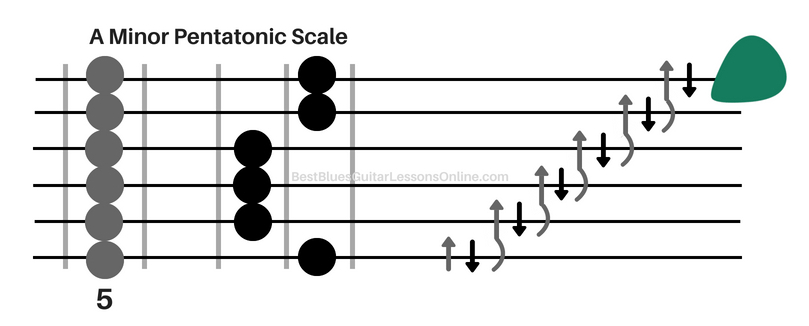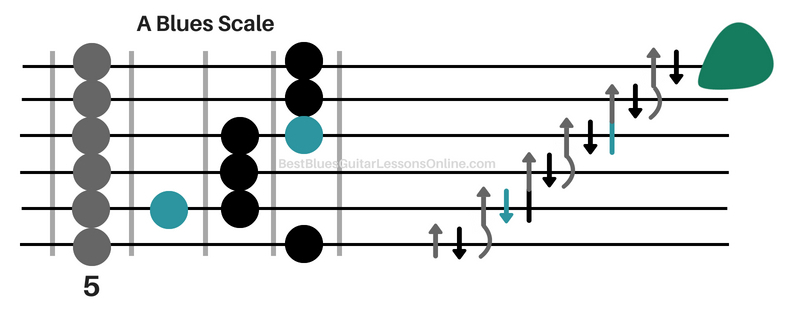How To Play Fast Blues Guitar Solos With The Best Blues Guitar Speed Building Strategies
Break Out Of Your Old Boring Pentatonic Scales Once And For All And Start To Truly Master The Blues By Increasing Your Blues Guitar Speed Drastically
By Antony Reynaert
There are a lot of guitarists that will never master blues guitar as a playing style. Everything they do and know about the blues merely scratches the surface. This goes from the scales they use to the technical ability they have and everything in between. This shouldn't come as a suprise, as many blues guitar resources are lacking in the depth of their application and as a result won't take you really far. In order to improve your blues guitar playing it is critical that you don't only learn about the best scale patterns to use, but you also learn the best ways to practice them from a technical point of view. This article will empower you to improve your guitar playing in two ways; by learning about the best scales for fast blues guitar playing and by knowing how to approach these scales from a technical point of view in order to build speed.
If you ever wanted to know what's over the horizon in your blues guitar advancement, this article will take you not one step, but a whole leap ahead of everyone else.
Why Your Chances Of Building Badass Speed In Your Blues Guitar Solos Are Very Slim If You Aren’t Using This Strategy
First, let’s investigate two really common scales all blues guitarists use for their improvisation:
- The minor pentatonic scale
- The blues scale
These scales are by far the most common and are used by all great blues players. There are however a lot of downsides if you limit yourself to ONLY playing these scales.
1. Minor Pentatonic Scale

As you can see from the image above, to hit the first two notes on the lowest, the guitar pick has to go down and up. After these two motions, the only way to go to next note of the scale, is to jump over the next string. This is very inefficient if you want to build some serious speed, as you waste precious time every time you have to jump over a string. In order to build speed, it’s not the fretting hand that usually forms the biggest challenge, it’s the picking hand.
2. Blues Scale

When taking a closer look at the blues scale, you notice that sometimes we play two notes a string and sometimes we play three notes a string. The problem in building speed with this scale pattern lays within the fact that the picking hand doesn’t have a clear set of instructions to perform the scale pattern. The picking hand has to switch constantly between either an ‘down-up’-motion (two notes on a string) or an ‘down-up-down’-motion (three notes on a string). The picking hand will because of this never know exactly what to play unless your brain takes time to think about the motion, which is also time that’s wasted. You’re definitely going to trip and miss a note or string by using this pattern to build serious speed.
Here’s The Best Strategy To Build Speed In Blues Guitar Solos
The biggest problems with both the pentatonic scale and the blues scale for building speed are the facts that the picking hand doesn’t have any efficient movements while performing the patterns. Every blues guitarist who improvises guitar solos will almost never look at the picking hand. Your picking hand will be left alone completely during a solo so building this hand into an efficient machine is key in letting it flow as smoothly as possible.
Habit is what needs to be created for the picking hand in order to build some serious speed. The way to do so is to make a clear set of tasks that can easily be built into the muscle memory, so you can set your picking hand on ‘auto pilot’. Let me introduce you to the three notes per string scale patterns:

The patterns above are a representation of the G major scale. The real benefit of these scale patterns are the three notes on EVERY string. This allows you to use directional picking while performing all notes from the scale.
The true asset of directional picking can be found in the fact that we NEVER have to jump strings and that the motion for the picking hand is the same throughout the ENTIRE scale. To perform the picking motion, we alter between alternate picking and sweep picking (sweep picking motion indicated in red on tablature below).
On the image and tablature below you can clearly see how to pick each string:


In order to know exactly how to practice these scales patterns (and any scale in general), I suggest to take a look at the video below because making mistakes on guitar in general is the result of practicing your scales on guitar the wrong way. Bad playing habits will limit not only your speed, but also your overall development as a guitarist in a way you will never grow to your full potential. In this video below I go over how to practice guitar scales in order to get the best results possible on guitar:
How To Implement This Speed Building Strategy Into Your Own Blues Guitar Playing Right Now
When playing a 12 bar blues in A, instead of playing the A blues scale, the A minor pentatonic or the A major pentatonic all the way through the progression, we are going the play the A Dorian mode in certain points of time. This allows us to come up with badass speed runs that will blow away everyone. This A dorian mode is actually the G major scale from a relative point of view. The Patterns for this scale can be found in the previous chapter of this article.
This is what you should do to incorporate the A dorian scale to finally build that speed in your blues guitar solos: Try to play A dorian over the I and IV chord of a 12 bar blues progression in the key of A. In the first video of the article, you can see me perform this strategy and get a real hang of how this will sound and affect your speed in your blues guitar solos.
|
I |
I |
I |
I |
|
IV |
IV |
I |
I |
|
V |
IV |
I |
I |
If you want to go deeper into the inner workings of how to play fast blues guitar parts, I encourage you to download my free how to play fast blues guitar licks guide where you will learn about the picking mechanics that you need to build speed and control in your guitar playing.
Start the Essential Blues Guitar Soloing Course now to break out of your old habits.
